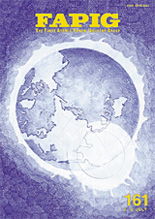![]()
FAPIG
THE FlRST ATOMlC POWER INDUSTRY GROUP
FAPIG誌 最新号目次
2002−7/平成14年度 第1号(No.161)

|
目 次 ■ 紹 介 ■ グループ情報 ● Fresh Information(川崎重工) (22) 表紙デザイン:酒井美菜子 CONTENTS ■ Introduction ● Fresh Information (KAWASAKI HEAVY INDUSTRIES) (22) Cover Design:Minako Sakai
SYNOPSES Taiju Shibata, Takayuki Kikuchi, Satoshi Miyamoto, Kazutomo Ogura,
Yoshinobu Ishigaki The I-I type irradiation equipment is the first irradiation rig for the HTTR. It will be served for the in-pile creep test for the standard size specimens of 316FR steel. Fabrication of the equipment was started in 1999. Its performances, such as the load transmission, temperature control and creep behavior measurement, were demonstrated outside the reactor in advance. It is now located temporally in the reactor building of the HTTR. After the demonstration of the performance of the HTTR, it will be installed in the reactor for the irradiation test. KEYWORDS:HTTR, irradiation rig, in-pile creep test Takumi Ashida, Kyotada Nakamura, Hiroshi Ogawa, Seitaro Ogiso Structural integrity assessment for nuclear class 1 components in Light
Water Reactor plant are performed based on “Design by Analyses” approach.
In order to achieve the fatigue damage evaluation according to the Japanese
structural integrity assessment code MITI501, the expert knowledge are
widely required as for not only FEM modeling, know-how to using the
FEM programs but theories about structural strength and the related
assessment codes and standards. KEYWORDS:Structural integrity assessment, MITI501, ReVIAS, NuPIAS, all in one PC systems Noriyuki Tsukino, Fumio Wani, Hideki Okado, Masahiro Shimada, Makoto
Izaki, Kunio Hara, Hidehiko Miyao, Masaharu Nakazawa The dismantling work of nuclear facilities for decommissioning requires the safe operation at the narrow space under highly radioactive condition. Therefore, the dismantling system is required to reduce the size of cutting devices and control remotely for safe operation. A remote cutting system with laser transmitted through optical fiber is promising the dismantling of nuclear facilities. The cutting system has been developed, and experimental study has been performed. Good results were obtained in the remote cutting test. KEYWORDS:decommissioning, laser cutting, Chemical Oxygen Iodine Laser Takeshi Izumi, Shigeo Miya, Takao Ino, Toshi Takai, Masahiro Hagiwara In nuclear power plants, the quality of the feed water should be kept
very clean for minimizing the corrosion of the materials of the systems.
One of the major impurities in the water is sulfate ion, which derives
from the leachables from cation exchange resins being used in the condensate
demineralizers. Therefore, reducing the amount of leachables from the
resins is the utmost requirement in the power plants. In oreder to satisfy
this requirement, the authors have developed the new cation exchange
resin with high crosslinkages and uniform particle size distributions. KEYWORDS:ion exchange resin, high crosslinkage, condensate demineralizers, leachables, cation exchange resin, molecular weight distribution, kinetics, regenerating characteristics, water retention capacity, leaching rate of TOC Morio Fujisawa, Kiyoshi Obara, Mitsugu Hirano, Yasushi Sakakibara Radioactive wastes are generated from those facilities that handle radioactive substances including nuclear power plants and usually such wastes are subjected to the volume reduction process and then subjected to the hardening process for stabilization and/or disposition. Among other radioactive wastes as the object of the hardening process, hardening with asphalt, hardening with plastics, and hardening with cement have so far been implemented for enriched waste liquid. However, in connection with the commencement of disposal by laying underground in Shimokita, a higher volume reduction rate than that in existing technologies has come to be required. Therefore, Fuji Electric Co., Ltd. has developed technology of hardening enriched waste liquid with vitrified cement using microwaves KEYWORDS:microwave, vitrification, hardening with cement, volume reduction, boric acid Tohru Nishida According as the rapid spread of Internet users, a lot of IT policies
have been carried out from some ministry. KEYWORDS:IT Strategy Head quarters , Electronic Government, "e-Japan Priority Policy Program", "G to C", "G to C", "G to B", IT policies, ministry |
バックナンバー目次
|
号数 |
発行年月 |
| 160 | 2002/ 3 |
| 159 | 2001/11 |
| 158 | 2001/ 7 |
| 157 | 2001/ 3 |
| 156 | 2000/11 |
| 155 | 2000/ 8 |
| 154 |
2000/
3
|
| 153 |
1999/11
|
| 152 |
1999/ 7
|
| 151 |
1999/ 3
|